Transport in Ile-de-France will be put to the test during the Olympic Games and their organizers have called for general mobilization to avoid chaos (AFP / Christophe ARCHAMBAULT)
Feats for athletes, walking distance records for others? Transport in Ile-de-France will be put to the test during the Olympic Games and their organizers have called for general mobilization to avoid chaos.
The authorities hammer it home: they are ready to welcome the approximately 7 million spectators expected from July 26 to August 11; the Ile-de-France Mobilités (IDFM) plan is finalized, thousands of shuttles are planned, 3,000 additional self-service bicycles have been deployed, nearly 400 km of cycle lanes have been developed.
But the transport of spectators during the Games, the first in history to prohibit car access to the sites, continues to cause concern while daily users are already confronted with a network that is often saturated and subject to disruptions. incidents.
To avoid thrombosis, IDFM has voted for reinforcements on most metro and RER lines, with on average 15% more trains than in a normal summer.
For the LR president of IDFM Valérie Pécresse, the network is largely adapted: it will involve transporting as many people as on a working day in winter, but with sudden peaks. We should exceed 500,000 spectators over at least two days, July 28 and August 2.
– “Take out your bike” –
In places, the offer has been significantly increased, such as on line 9 where there will be 61% more metros to serve the Parc des Princes and Roland-Garros, an area where saturation is feared.
The RER C, often in difficulty, will see its offer jump by 71% in Paris during the competition, according to IDFM. As for the RER A, its rate must increase by 66%.
Above all, new infrastructures will open, such as the extension of line 14 to Orly airport in the South and Saint-Denis-Pleyel in the North of Paris.

A bicycle on the Place du Trocadéro in Paris, March 27, 2024 (AFP / Dimitar DILKOFF)
Despite the means deployed, the authorities are calling on those who can to avoid transport during the period. “You shouldn’t be afraid to do a little walking, it’s good for your health,” said Ms. Pécresse. “Perhaps it’s time to get out your bike,” added Minister Delegate for Transport Patrice Vergriete.
In May, IDFM must present its “Paris Public Transport 2024” application which should make it possible to distribute spectator flows.
The government has already launched the site anticipaterlesjeux.gouv.fr, where everyone can test and adapt their route. It is notably illustrated… by a photo of a woman teleworking.
For motorists, this will involve avoiding closed areas and taking into account the bottlenecks of the “Olympic lanes” reserved for accredited persons.
These routes “are going to be restrictive”, concedes David Juin, responsible for road coordination of the Games for the Ile-de-France Roads Directorate (Dirif), nevertheless saying he is “rather confident” because traffic is less important at the base in summer.
In 2012 during the London Olympics, the authorities managed to reduce road traffic by 15%.
– Pre-positioned agents –
“The objective is to give information to users upstream”, via the Dirif traffic application “Sytadin”, the traffic radio 107.7 FM or on the illuminated signs on the highways, adds Mr. Juin, whose The administration will pre-position hundreds of agents to “intervene much more quickly” on any incident.

The manager of Paris airports ADP does not expect a “significant increase in traffic” compared to a normal summer (AFP / STEFANO RELLANDINI)
The manager of Paris airports, ADP, has also put itself in battle order, even if it does not expect a “significant increase in traffic” compared to a normal summer, when Paris-Charles-de-Gaulle ( CDG) sees more than 200,000 passengers pass through per day and Orly 100,000.
ADP has reserved routes for delegations, including, initially, baggage check-in at the Olympic Village and a dedicated terminal at CDG. “The infrastructures are ready”, including ten new hand baggage inspection lines at CDG and five at Orly, confides Edouard Arkwright, executive general director of ADP.
But two critical periods are looming: CDG and Orly will be closed on the evening of July 26, the start of a weekend of big departures, because flying will be prohibited within a radius of 150 km around Paris during the opening ceremony. The system will also be powered on in the 48 to 72 hours after the closing ceremony, when a large part of the accredited and spectators will leave.
